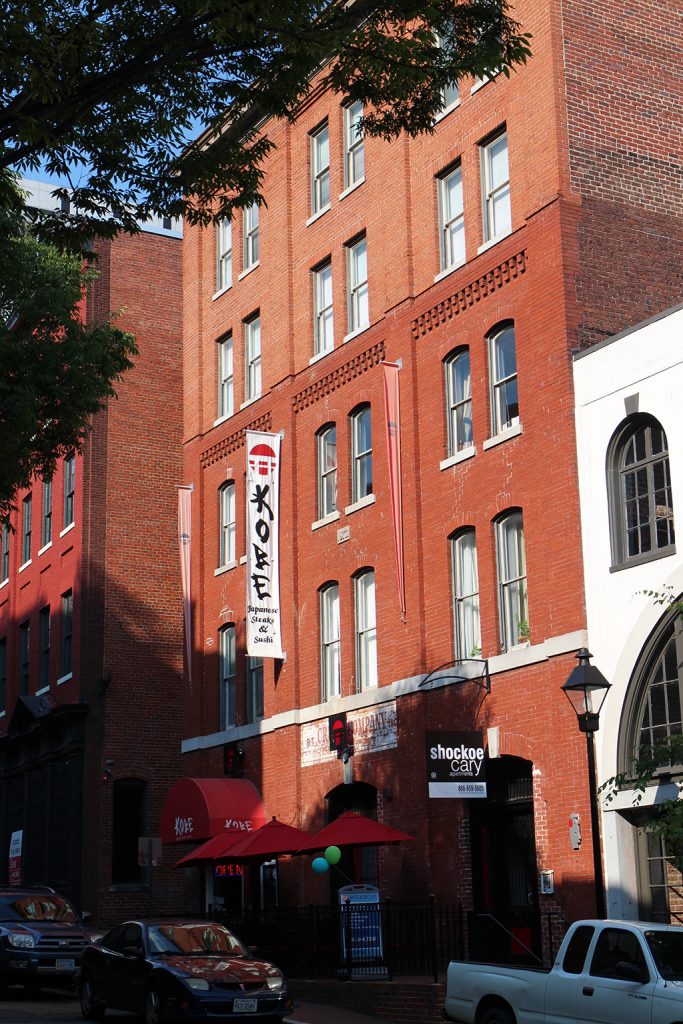Eleven minutes and a $100 bid helped send a downtown building into the hands of its lender.
The Shockoe-Cary Building at 19-21 S. 13th St., which sits at the corner of East Cary Street, was foreclosed on at an auction on Wednesday. It is now controlled by Torchlight Investors, a special servicer acting on behalf of the property’s noteholder.
The five-story property, which houses 16 apartments and the Kobe Japanese Steaks and Sushi restaurant, had been owned by Shockoe-Cary Building LP, which took control over the building in 2002 for $0 from Shockoe-Cary Building LLC. Rick Gregory, a founder and managing partner at Fountainhead Properties, is the registered agent for Shockoe-Cary Building LP.
Yesterday’s auction was prompted by Shockoe-Cary Building LP defaulting on a $2.7 million loan originally issued in 2007 by Column Financial. The note changed hands several times before being assigned to Torchlight in March.
John H.C. Barron, Jr. of law firm Duane Morris was on hand on the steps of the Richmond Circuit Court to bid on behalf of Torchlight. He said some prospective buyers had expressed interest in the Shockoe-Cary Building leading up to the auction but their offers weren’t what the lender had in mind.
“We had some people who were interested at a discounted amount that the lender can’t entertain,” Barron said. “The lender was prepared to bid the full amount of the debt.”
Instead, Barron carried the day with a written bid of $100. He said the plan now will be get back control of the Shockoe-Cary Building, assess its fiscal and physical states, and eventually sell it. He said there were no immediate plans to make any changes at the building.
Eleven minutes and a $100 bid helped send a downtown building into the hands of its lender.
The Shockoe-Cary Building at 19-21 S. 13th St., which sits at the corner of East Cary Street, was foreclosed on at an auction on Wednesday. It is now controlled by Torchlight Investors, a special servicer acting on behalf of the property’s noteholder.
The five-story property, which houses 16 apartments and the Kobe Japanese Steaks and Sushi restaurant, had been owned by Shockoe-Cary Building LP, which took control over the building in 2002 for $0 from Shockoe-Cary Building LLC. Rick Gregory, a founder and managing partner at Fountainhead Properties, is the registered agent for Shockoe-Cary Building LP.
Yesterday’s auction was prompted by Shockoe-Cary Building LP defaulting on a $2.7 million loan originally issued in 2007 by Column Financial. The note changed hands several times before being assigned to Torchlight in March.
John H.C. Barron, Jr. of law firm Duane Morris was on hand on the steps of the Richmond Circuit Court to bid on behalf of Torchlight. He said some prospective buyers had expressed interest in the Shockoe-Cary Building leading up to the auction but their offers weren’t what the lender had in mind.
“We had some people who were interested at a discounted amount that the lender can’t entertain,” Barron said. “The lender was prepared to bid the full amount of the debt.”
Instead, Barron carried the day with a written bid of $100. He said the plan now will be get back control of the Shockoe-Cary Building, assess its fiscal and physical states, and eventually sell it. He said there were no immediate plans to make any changes at the building.




Hello;
I’m sure this is old hat to people in this line of work, but if someone had showed up with 200.00 cash could they have actually bought the building?
I had that same question in mind as well, Ed. If so, I’ve been eyeballing some warehouses in Scott’s Addition and Manchester I’d like to pick up for a song (and $100, of course!).
Thanks for commenting, BizSense readers. Typically, bidders at foreclosure auctions are required to submit a sizeable, refundable deposit prior to the auction. The Shockoe-Cary Building called for a $100,000 deposit from anyone wanting to bid. Additionally, the lender/noteholder foreclosing on the property typically has a minimum figure in mind and would be prepared to counter low bids to get the auction price up to that level or to a level where it would take control. Hope that helps, and thanks again for commenting.
Mike, Ed and Kory:
It looks like the lender “bid in”. In effect, the lender used its own money as the purchase price. Lenders will usually set up a single purpose entity owning only one asset, like this building, to handle the property after the lender has foreclosed and taken control.
The lender will almost always bid the note. Meaning, any bid from anyone else than the lender will have to be more than the outstanding balance on the loan to actually be in play.
Looks like that was $2.7m, ignoring amortization, here